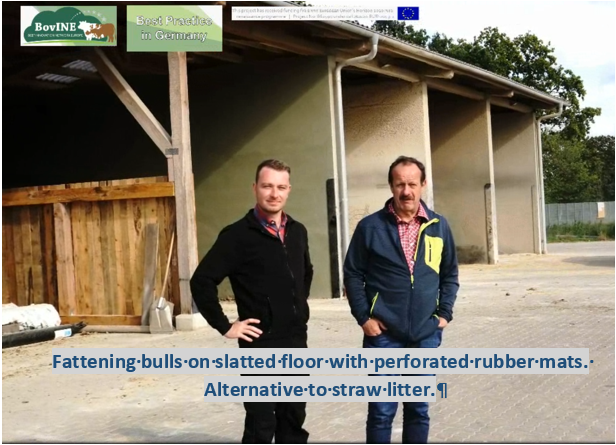In Lower Saxony (Germany), the rebuilding and new construction of stables for cattle fattening requires lying surfaces that are soft-elastic, deformable and heat-insulating. The farm presented here has chosen a combination of concrete slats and rubber mats for the construction of its barn in 2016.
It is a stable for 300 bulls (Simmental, all from one breeder) in 30 pens. The pens are 5.50 m wide and 6.50 m deep (3.5 m2 per animal). 2/3 of the floor in the pens is topped with perforated LOSPA mats (costs approx. 170 EUR per animal place), the remaining third has bare concrete slats.
Please click on the picture, to see the video (Video: F. Zerbe)!
The rubber mats offer a soft lying surface and good surefootedness for the animals furthermore the heat dissipation of the animals is low. The combination with the concrete still ensures sufficient hoof abrasion.
It is a challenge to keep the floor and thus the animals dry. Wet ground and wet claws promote diseases, furthermore, animals in damp pens get dirty faster and damp skin is more prone to injuries. Due to a slight slope in the floor and good ventilation by means of spaceboard-ridge ventilation, the rapid drying off in this barn is well solved. The higher costs for the mats pay off, as no litter or manure management is required.
For farms without access to straw, rubber mats are an alternative. However, for the successful use of rubber mats, a good ventilation is important and the combination with concrete can make sense in terms of hoof wear.
This Good Practice has an Impact on:
- Socio economic resilience: Costs for rubber mats (service life 8-10 years) have to be compared with the costs for straw and litter / manure management. The selected stocking density is a node in which decisions on cost efficiency, animal performance and health as well as consumer acceptance are condensed
- Animal health and welfare: Well-drained rubber mats and a good stable climate lead to animal husbandry with little animal soiling. Dry claw horn is more robust, dry skin is less sensitive to external influences. The disadvantage of rubber is the lower horn abrasion, which is why floor with higher abrasiveness should be part of the pen's surfaces.
- Production efficiency and meat quality: Farmers are obliged to control animals. In order to be able to meet this appropriately, the pens should be manageable (the distance to the animal should not be too great). Better cleanliness of the animals facilitates their assessment (health monitoring).
- Environmental sustainability: Stocking densities influence the entry of urine and faeces on the area. Good drainage reduces urea, which is converted into NH3 and CO2 by microbial urease on aerobic surfaces (soil, skin). Less moisture allows these surfaces to dry out more easily and thus results in lower emissions. Recycling aspects: Mats are made from old car tires.

In terms of rubber mats there are some more Good Practices and Research Innovations on the BovINE Knowledge Hub:
- Rubbermats on slats - the animal welfare version of slats?
- The use of rubber coverings/mats on slats to improve animal welfare
- Use of rubber mats on slatted floors
